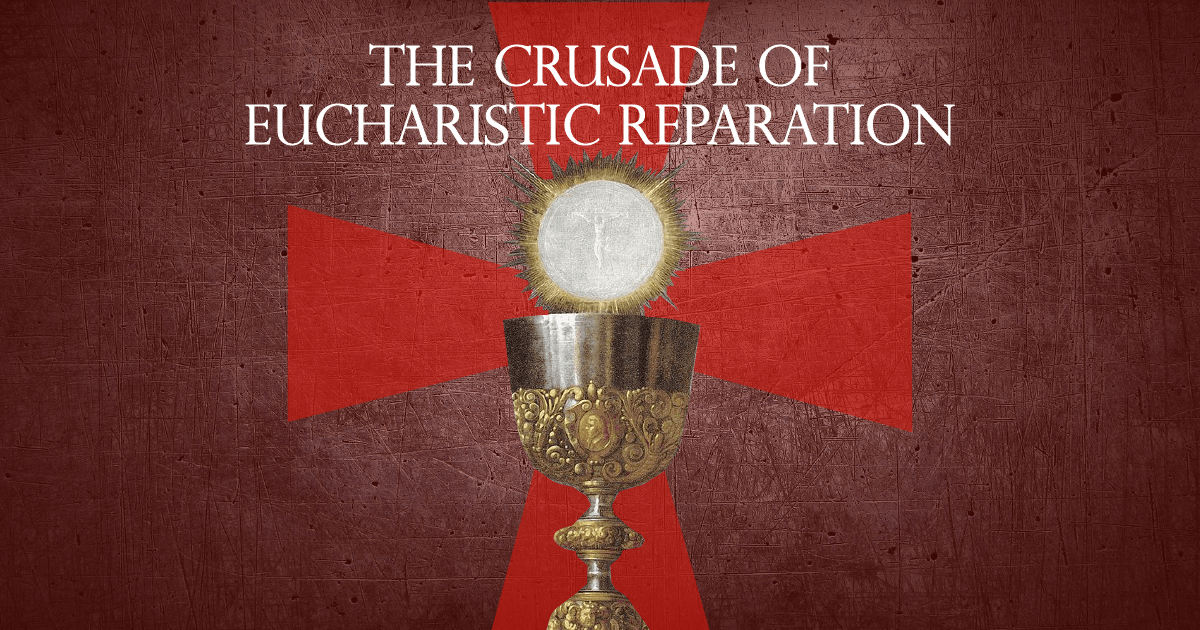The Lifting of the Chasuble at the Elevations: Touching the Hem of Christ’s Garment
Above: Detail from a stained glass window, St. Francis of Assisi Chapel, Lincoln, NE All of us who have sufferings to bear and faith in Jesus have a desire to be healed by Him, in some way, at some level. […]
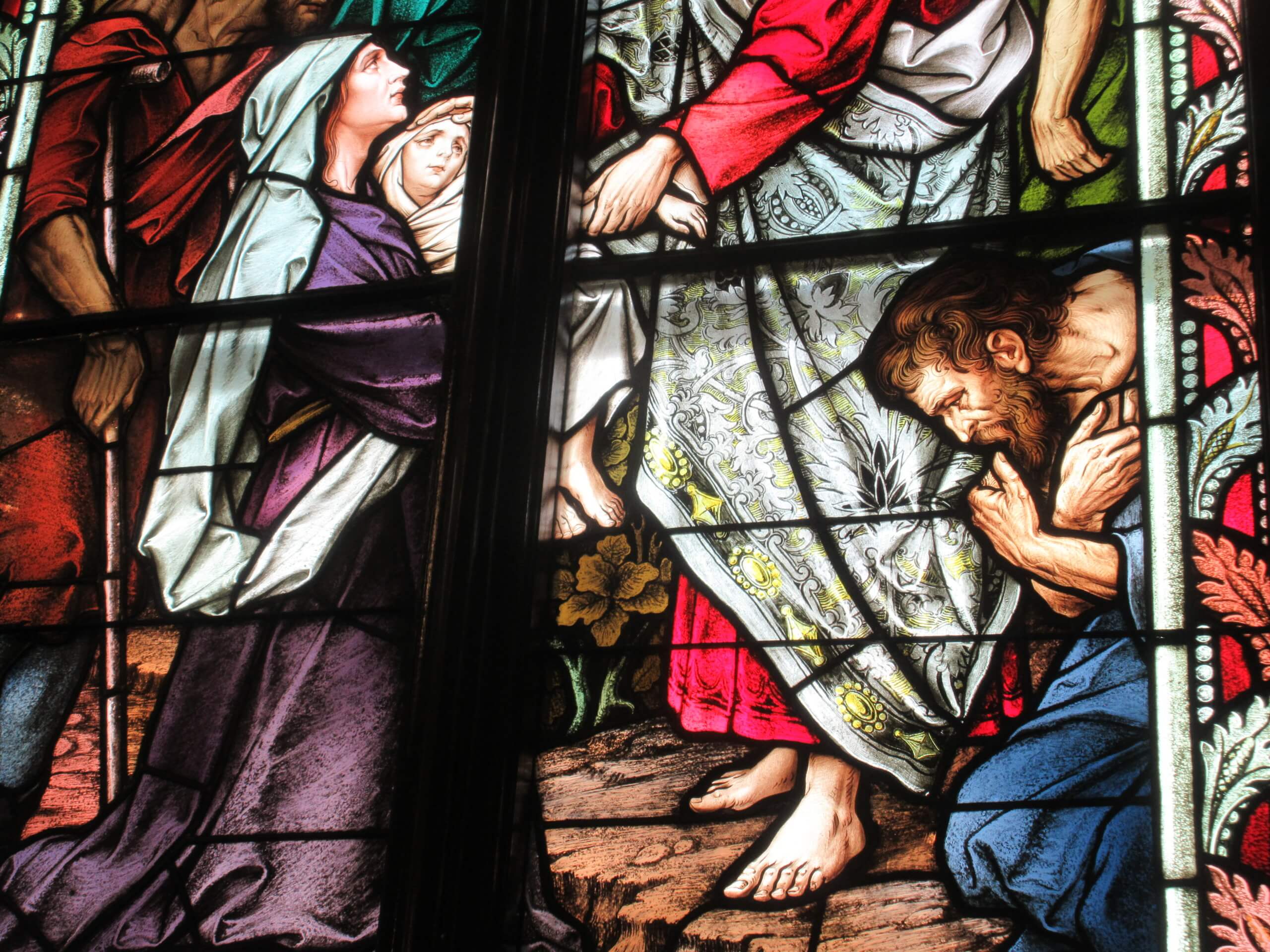
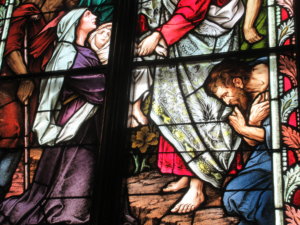
Above: Detail from a stained glass window, St. Francis of Assisi Chapel, Lincoln, NE
All of us who have sufferings to bear and faith in Jesus have a desire to be healed by Him, in some way, at some level. We see in the Gospels that the obvious way in which to go about this was to seek to touch Jesus or to have Him touch one. Everyone saw that Jesus was powerful to heal, that healing “went out from Him,” and therefore they elbowed and jostled their way to see if they could attract His attention and even come into contact with His hand or His garment or even His shadow.
Let’s recall a few of these moments. There are times when Jesus took the initiative in contacting someone. “Jesus stretching forth his hand, touched him, saying: I will, be thou made clean. And forthwith his leprosy was cleansed” (Mt 8:3). Of Peter’s mother-in-law: “And he touched her hand, and the fever left her, and she arose and ministered to them” (Mt 8:15). “Then he touched their eyes, saying, According to your faith, be it done unto you. And their eyes were opened” (Mt 9:29–30; cf. Mt 20:34). At the Transfiguration: “The disciples hearing [the voice from heaven] fell upon their face, and were very much afraid. And Jesus came and touched them: and said to them, Arise, and fear not” (Mt 17:6–7). “And they bring to him one deaf and dumb; and they besought him that he would lay his hand upon him. And taking him from the multitude apart, he put his fingers into his ears, and spitting, he touched his tongue: And looking up to heaven, he groaned, and said to him: Ephpheta, which is, Be thou opened. And immediately his ears were opened, and the string of his tongue was loosed, and he spoke right” (Mk 7:32–35). “They brought unto him also infants, that he might touch them” (Lk 18:15).
But there are other times when someone else took the initiative in touching Jesus: “A very great multitude of people from all Judea and Jerusalem, and the sea coast both of Tyre and Sidon, Who were come to hear him, and to be healed of their diseases. And they that were troubled with unclean spirits, were cured. And all the multitude sought to touch him, for virtue went out from him, and healed all” (Lk 6:17–19). “When the men of that place had knowledge of him [i.e., that he had arrived in their territory], they sent into all that country, and brought to him all that were diseased. And they besought him that they might touch but the hem of his garment. And as many as touched, were made whole” (Mt 14:35–36). One of the most beautiful of these scenes is recounted as follows, in St. Mark’s version:
And a woman who was under an issue of blood twelve years, And had suffered many things from many physicians; and had spent all that she had, and was nothing the better, but rather worse, When she had heard of Jesus, came in the crowd behind him, and touched his garment. For she said: “If I shall touch but his garment, I shall be whole.” And forthwith the fountain of her blood was dried up, and she felt in her body that she was healed of the evil. And immediately Jesus knowing in himself the virtue that had proceeded from him, turning to the multitude, said: “Who hath touched my garments?” And his disciples said to him: “Thou seest the multitude thronging thee, and sayest thou who hath touched me?” And he looked about to see her who had done this. But the woman fearing and trembling, knowing what was done in her, came and fell down before him, and told him all the truth. And he said to her: “Daughter, thy faith hath made thee whole: go in peace, and be thou whole of thy disease.” (Mk 5:25–34; cf. Mt 9:20–22)[1]
In St. Matthew’s and St. Luke’s telling, the woman comes behind Jesus and touches “the hem of his garment,” a detail well captured in the fourth-century painting found in the catacombs of Marcellinus and Peter in Rome:

Why does this story move us and appeal to us? Because the Haemorrhoissa is Everyman. We have all expended our energy and money on worldly remedies that have let us down, leaving us worse than before; we are more or less hoping Christ will cure us but struggling with the fear of going to Him or being openly seen with Him. The happy ending to her story is the one we also desire, and so we must imitate her faith and boldness.
In two moving passages of his Spiritual Diary, Sergius Bulgakov alludes to the healing of the woman with the issue of blood:
Out of the depths have I cried unto thee, O Lord [Ps. 130:1]. When sorrow overwhelms the heart and gloom descends on the soul, You, O Lord, only You are my comfort and my refuge. I grasp at the hem of Your garment [Matt. 9:20], and my grief subsides, and joy, graced joy, floods my heart. And I feel that nothing can take this joy from me. But when in my cowardice I let go of the hem of this garment, I drown [Matt. 14:30].[2]
But always a feeling of heaviness oppresses you, a feeling of impotence, of distance from God. It seems then that it is not you who is far from God, but God who is far from the world, and unbelief imperceptibly steals into the soul and fills it with its cold, icy solitude. A cold and icy heart is far from the Sun. So turn to Him, hold fast the edge of His garment with your hand [Matt. 9:21]; grow faint, but desire to love Him more than yourself, more than your life, more than what is dearest to you, be ready to give up everything, everything for the sake of love for God [Matt. 10:37]. And in your heart a fire will ignite in response, the ice will melt, your eyes will be moistened with tears; the heart will ignite and tremble, it will catch the scent of the nearness of heaven. And once again you will find all your dearly beloved ones, and the world will light up in its beauty, and the darkness of your soul will become the light of joy, and your whole soul will fall, in blissful exhaustion, into the hands of the Lord. O Most Sweet Jesus, Bridegroom of my soul, joy eternal, come into the chamber of my soul, be with me, sup with me [Rev. 3:20], do not leave me. I call to You, I love you, I pray to You, Jesus, my Lord![3]
These passages offer new kindling for meditation on one of the innumerable customs that inhabit the ample sphere of the Roman rite, namely, the custom of the server(s) or deacon lifting the chasuble of the priest during the elevations of the Host and the Chalice. The lifting of the hem of the priest’s outer garment—that is, symbolically touching the power of Christ the High Priest and Savior—brings to mind the whole of the foregoing narratives and theology.
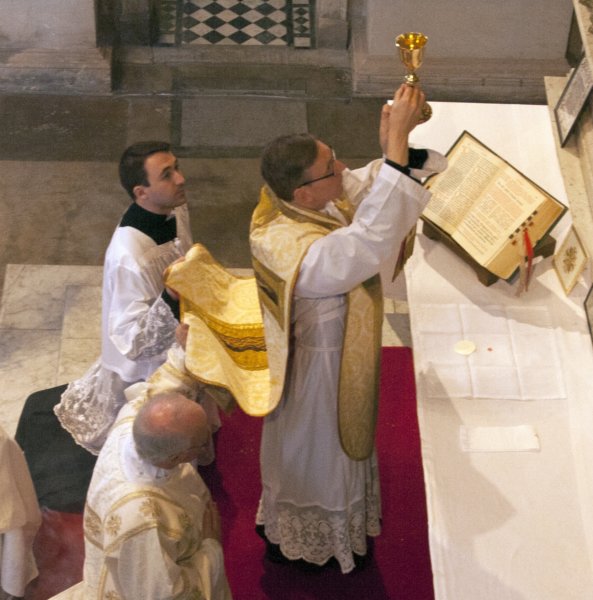
Having a practical origin, this custom quickly acquired a symbolic or allegorical meaning. As Michael Fiedrowicz explains:
Particular liturgical elements that were originally introduced because of practical requirements or other reasons determined by history could take on new, symbolic meanings in later epochs, which allow them to transcend time and make them worth protecting. For example, at the elevation of the Host and chalice, according to the instructions of the rubrics, the servers are to lift the priest’s chasuble, which was necessary originally because of the design of the medieval bell chasuble and its heavy, richly-ornamented material. Today this custom is retained, despite modified forms of vestments, not least of all because of its beautiful and symbolic meaning when one recalls the woman with an issue of blood who was healed by touching the hem of Christ’s garment (cf. Mt 9:20f.) and then sees in this gesture a symbol of the sanctifying power that emanates from the Sacrament of the Altar.[4]
I comment on this, too, in my book Reclaiming Our Roman Catholic Birthright, when explaining the fittingness of the ad orientem posture:
The celebrating priest, configured to Christ by virtue of his ordination, becomes a living iconostasis before the altar: an image standing there, revealing not himself but the Lord. The kind of chasuble customarily worn in the traditional liturgy is more elaborately decorated on the back because it is meant to be seen from behind. The priest disappears into his role, so that, when the servers pick up the edge of the chasuble at the elevations of the Host and the Chalice, we know that we, too, in imitation of the woman suffering the issue of blood, can take hold of the garment of Christ and be healed (cf. Mt 9:20–21; Mt 14:36). In this double elevation, the whole of creation, together with our hearts, is lifted to God, restored to Him in act and in promise (36).
This much is already familiar to many Catholics from experience or from devotional literature of the preconciliar period. (It definitely counts as fringe behavior, especially after July 16, 2021.)
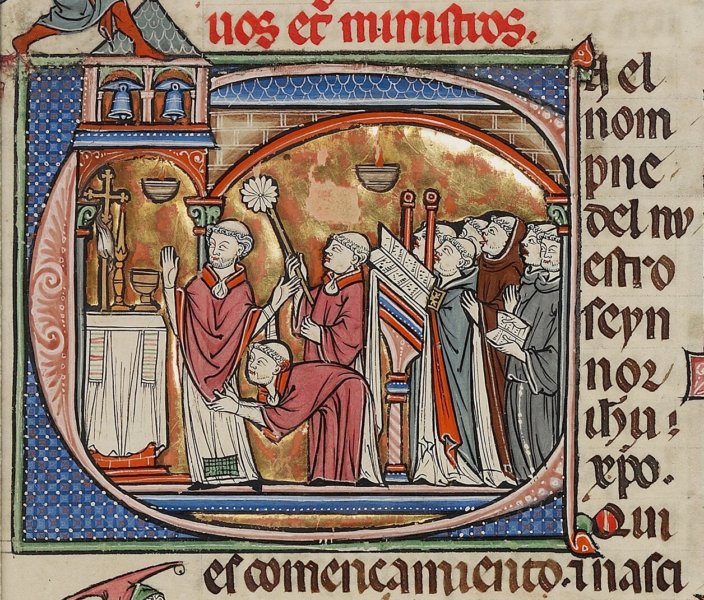 A Priest Celebrating Mass, manuscript, ca. 1290–1310 (source)
A Priest Celebrating Mass, manuscript, ca. 1290–1310 (source)
In the Roman Mass as it developed, therefore, we see a subtle and judicious sequence. First, by the hand of the server, we touch the High Priest externally by taking hold of the edge of His garment. The layman is doubling removed: he himself does not touch the garment; and, after all, it is only a garment, not the person as such. Second, by a mercy we will never be able to comprehend, much less give worthy thanks for in this life, the one who has a clean conscience may approach the Holy Banquet to touch the Lord Himself—nay, to receive His glorified flesh, with His ransoming blood and His all-holy soul and His life-giving divinity, into his own body and soul, going far, far beyond anything that any of the suffering clients of Our Lord in the Gospels ever dreamed of.
Why such emphasis on touching the Lord? Perhaps no one has expressed the rationale better than Charles Cardinal Journet:
At a fixed time, not content with reaching out to men from the depths of his inaccessible light, God himself began to appear visibly in their midst and to cure their wounds by the sensible contact of his humanity.… During the temporal life of our Savior, grace already began to be poured out on the Church, which he assembled around himself by his immediate sanctifying contact…. If Christ had remained among us [according to His visible humanity], he would have been able to touch with a sensible contact only a small number of men; but in leaving this world he would be able, by the intermediary of a hierarchy that he sends across space and time, to touch corporeally the whole of humanity…. And in order that he may continue to approach us with the same intimacy as during the days of his mortal life, Jesus leaves in our midst the mediation of the hierarchic powers and the sacramental rites, which prolong his sensible contact with the whole world, and under the species of which he will send the fullness of grace and truth: “Go, make disciples of all nations, baptizing them… teaching them…. Behold, I am with you always, to the close of the age” (Mt 28:19–20).[5]
And again:
It is the action by contact that founds the Church in her state of plentitude and perfection. It is the action by contact that Christ strives to multiply, in a certain sense, when he passes to the other side of the sea in order to heal the possessed man, when he travels the roads of Judea and Galilee, even to the borders of Phoenicia. It is this contact that he willed to continue in time, when, on the point of leaving us, he instituted a visible hierarchy in our midst; from his heavenly home he uses this hierarchy as a corporeal instrument in order to maintain this sensible contact with us (Mt 16:19). It is this contact that he wishes to extend to all the nations (Mt 28:19), even unto the ends of the earth (Acts 1:8) and the end of time (Mt 28:20), and that continuously gives birth to his Church. It is this contact that, by means of the sacraments of the New Law—which are like the hands of Christ reaching out to us across space and time—confers on us (according to our proper disposition) the sanctity of Christ, with all the treasures that are his own…. It is by the contact of the sacraments that fully Christic, fully Christ-conformed, and fully Christ-conforming grace comes to the Church.[6]
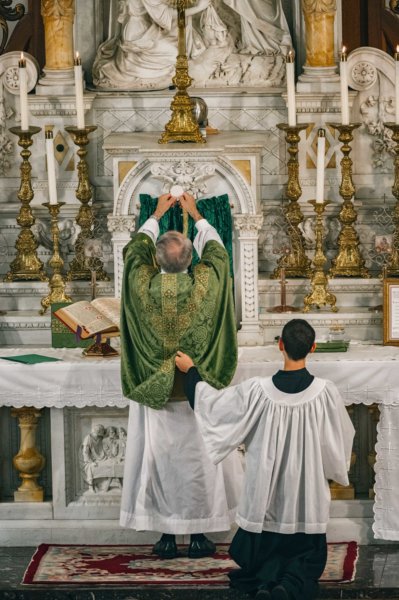
It is precisely in keeping with the wonderful pedagogy of the Mass that the gift of intimate union with the Lord is impressed on us all the more by the initial sight of a server lifting the chasuble of the priest. The “distance” between us and the sanctuary, the vicarious nature of what is being done on our behalf, is a sort of anticipation and symbol of the closeness and healing we hope to obtain.[7] It may even be seen as a symbol of our desire to assist the Lord in the offering of Himself, as we enter more deeply into His act of redemptive sacrifice, “completing in [our] flesh what is lacking in Christ’s afflictions for the sake of His body, that is, the Church (Col 1:24).
The Lord confronted His enemies with these words: “Woe to you lawyers also, because you load men with burdens which they cannot bear, and you yourselves touch not the packs with one of your fingers” (Lk 11:46). God the Father does load us with burdens, but our burdens are bearable—and He Himself touches us with His finger, with the Holy Spirit and with the Holy Eucharist—to ensure that we can carry our cross all the way to glory.
[1] It is delightful to compare how St. Luke tells the same story and to see the differences: “And there was a certain woman having an issue of blood twelve years, who had bestowed all her substance on physicians, and could not be healed by any. She came behind him, and touched the hem of his garment; and immediately the issue of her blood stopped. And Jesus said: Who is it that touched me? And all denying, Peter and they that were with him said: Master, the multitudes throng and press thee, and dost thou say, Who touched me? And Jesus said: Somebody hath touched me; for I know that virtue is gone out from me. And the woman seeing that she was not hid, came trembling, and fell down before his feet, and declared before all the people for what cause she had touched him, and how she was immediately healed. But he said to her: Daughter, thy faith hath made thee whole; go thy way in peace” (Lk 8:43–48).
[2] Sergius Bulgakov, Spiritual Diary, ed. and trans. Mark Roosien and Roberto J. De la Noval (Brooklyn: Angelico Press, 2022), 55.
[3] Ibid., 99.
[4] Michael Fiedrowicz, The Traditional Mass: History, Form, and Theology of the Classical Roman Rite, trans. Rose Pfeifer (Brooklyn: Angelico Press, 2020), 212. Joseph Shaw notes: “An anthropologist would say that this is a fact of life about culture: meanings commonly become attached to practices, not the other way round. A Christian could attribute this kind of development to Divine Providence. In neither case is this a matter of an infinitely malleable meaning: the context sets limits to what makes sense, and later ways of understanding it build upon earlier ones. The more this development goes on, the more meaning there is for the worshipper to discover, and also the more detailed context there is for later commentators.”
[5] Charles Journet, The Theology of the Church, trans. Victor Szczurek (San Francisco: Ignatius Press, 2004), 44–47.
[6] Ibid., 72–73.
[7] See my lecture “The Relationship between Priest and People in the Latin Mass: Space and Time for Divine Intimacy.”












